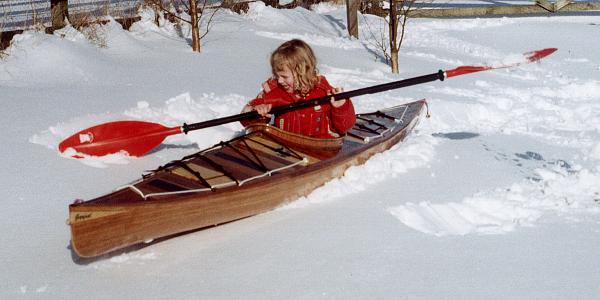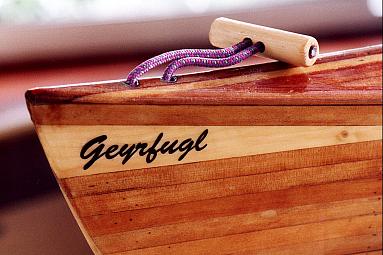In May 2001, my children were taking an interest in kayaking, and I had returned from my first long weekend sea kayaking off Kintyre (Western Scotland) incredibly enthused. Even Mary, my wife, thought that it must be worth doing if I could be that enthusiastic, so I set about looking for the best way to be able to go sea kayaking with the whole family. Initial ideas centred on a double or treble seat kayak, since sea kayaks didn't seem to be made in kids' sizes. Then a chance contact brought the opportunity to buy an old McNulty Seaglass Horizon double for fifty quid. This would probably not be good on the open sea (rather a flat bottom to behave well in decent sized waves), but would certainly get us going on sheltered water. My mind then turned to using this in conjunction with my existing sea kayak (a North Shore Mistral) and something suitable for one child to paddle.
This brought us back to finding something other than a plastic white water type kayak (of which the smallest I could get was still designed for much heavier paddlers than my children). More web searching was making me think I should build something myself. On the shelf in Knoydart kayaking system's shop in Keswick was Nick Schade's book "The Strip-built Sea Kayak" which I read cover-to-cover (several times). Observing this, Mary stressed that I "needn't think you are building a kayak". So I started to look at scaling published (free) designs to suit a small child who was unlikely to grow into a large (or even medium sized) adult.
 My daughter Sarah is below the 1st centile on child
growth charts. As an adult - if she is still interested in activities like
kayaking - she will probably be no more than 40 kg (90 lb). A scaled-down
strip-built kayak was likely to be under 15 kg, and a boat designed for
camping weekends in the next few years should still serve as a day-boat in a
decade (Sarah was seven last summer). This suggested something with a design
displacement of up to about 60 kg. With a paddler currently weighing 16kg, a
load of camping gear would provide ballast, and a wide beam would hardly be
needed to provide a stable boat. With a pretty small muscle mass to drive the
boat, a narrow beam and longish waterline length would clearly provide the
best chance for Sarah to keep up a fair pace for long enough to feel that we
had got somewhere in the course of a day on the water. A wide beam would also
make it difficult for a small (currently 117cm tall) paddler to wield a
paddle effectively. As Michael (a couple of years younger) gets big and
coordinated enough to paddle, we could do longer trips by letting the kids
take it in turns between the front cockpit of a double (nowadays, that would
be our Arctic Star) and the kids' boat.
My daughter Sarah is below the 1st centile on child
growth charts. As an adult - if she is still interested in activities like
kayaking - she will probably be no more than 40 kg (90 lb). A scaled-down
strip-built kayak was likely to be under 15 kg, and a boat designed for
camping weekends in the next few years should still serve as a day-boat in a
decade (Sarah was seven last summer). This suggested something with a design
displacement of up to about 60 kg. With a paddler currently weighing 16kg, a
load of camping gear would provide ballast, and a wide beam would hardly be
needed to provide a stable boat. With a pretty small muscle mass to drive the
boat, a narrow beam and longish waterline length would clearly provide the
best chance for Sarah to keep up a fair pace for long enough to feel that we
had got somewhere in the course of a day on the water. A wide beam would also
make it difficult for a small (currently 117cm tall) paddler to wield a
paddle effectively. As Michael (a couple of years younger) gets big and
coordinated enough to paddle, we could do longer trips by letting the kids
take it in turns between the front cockpit of a double (nowadays, that would
be our Arctic Star) and the kids' boat.
Scaling Nick Schade's Great Auk design by 5/6th, giving a ten inch form spacing, was one of a number of ideas I looked at. This produces an overall length of 4.3m, more than half a metre shorter than my North Shore boat, but with a pretty similar waterline length. At 51 cm beam, the boat would be narrow, but in proportion, and quite fast (or quite efficient, for a weaker paddler). The displacement goes down as the cube of the linear scale, dropping from the 216 lb of the original design to 125 lb (56.5 kg) which was about right. By scaling the strips down to 5mm thick, I could get a pretty exact scaling of the hull just by scaling the forms down. With a smaller mass paddler at the centre of a shorter boat, the bending moment is much reduced, so I reckoned on a single layer of 4 oz glass, with maybe an extra layer on the bottom for abrasion resistance.
Mary's last word on the subject was "You are not building a kayak!!" So I bought a bandsaw and started cutting 5mm thick strips from a quantity of 3m planks of tongue-and-groove red cedar which had been removed from a ceiling in the house several years ago. This was only 5/8 inch board, so I reckoned that milling a cove and bead into it would result in rather narrow strips (and I'd have to buy another big power tool which I couldn't really justify). I decided that I would bevel the edges as required with a block plane. A sheet of cheap 12mm plywood and a suitable strongback were soon delivered. This was last summer (2001), the start of the building process, which took about seven months, including a longish period of inactivity in the middle.
 The name: I think boats
should have names, and particularly a one-off hand-built boat. I went looking
for a Great Auk graphic on the web, and found lots of interesting material,
including the local names of this bird in various languages. Geyrfugl
is the Icelandic name for a Great Auk, and it came down to a toss-up between
this and the Scots Gaelic name(s). The boat will probably be used mainly in
Scotland, but the English find Gaelic names notoriously difficult to
pronounce and I wanted a name that people would at least be able to say, so
Geyrfugl she became.
The name: I think boats
should have names, and particularly a one-off hand-built boat. I went looking
for a Great Auk graphic on the web, and found lots of interesting material,
including the local names of this bird in various languages. Geyrfugl
is the Icelandic name for a Great Auk, and it came down to a toss-up between
this and the Scots Gaelic name(s). The boat will probably be used mainly in
Scotland, but the English find Gaelic names notoriously difficult to
pronounce and I wanted a name that people would at least be able to say, so
Geyrfugl she became.